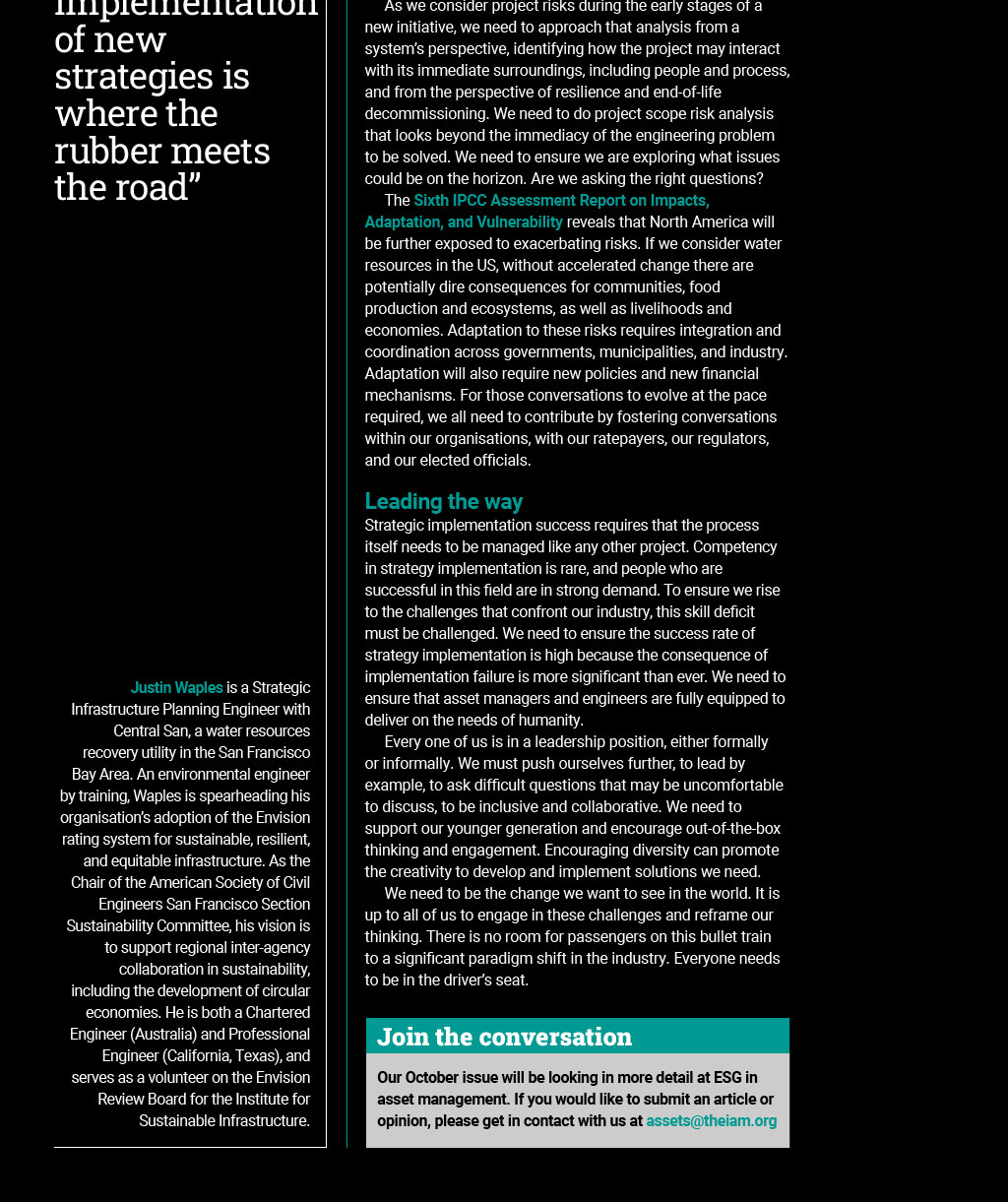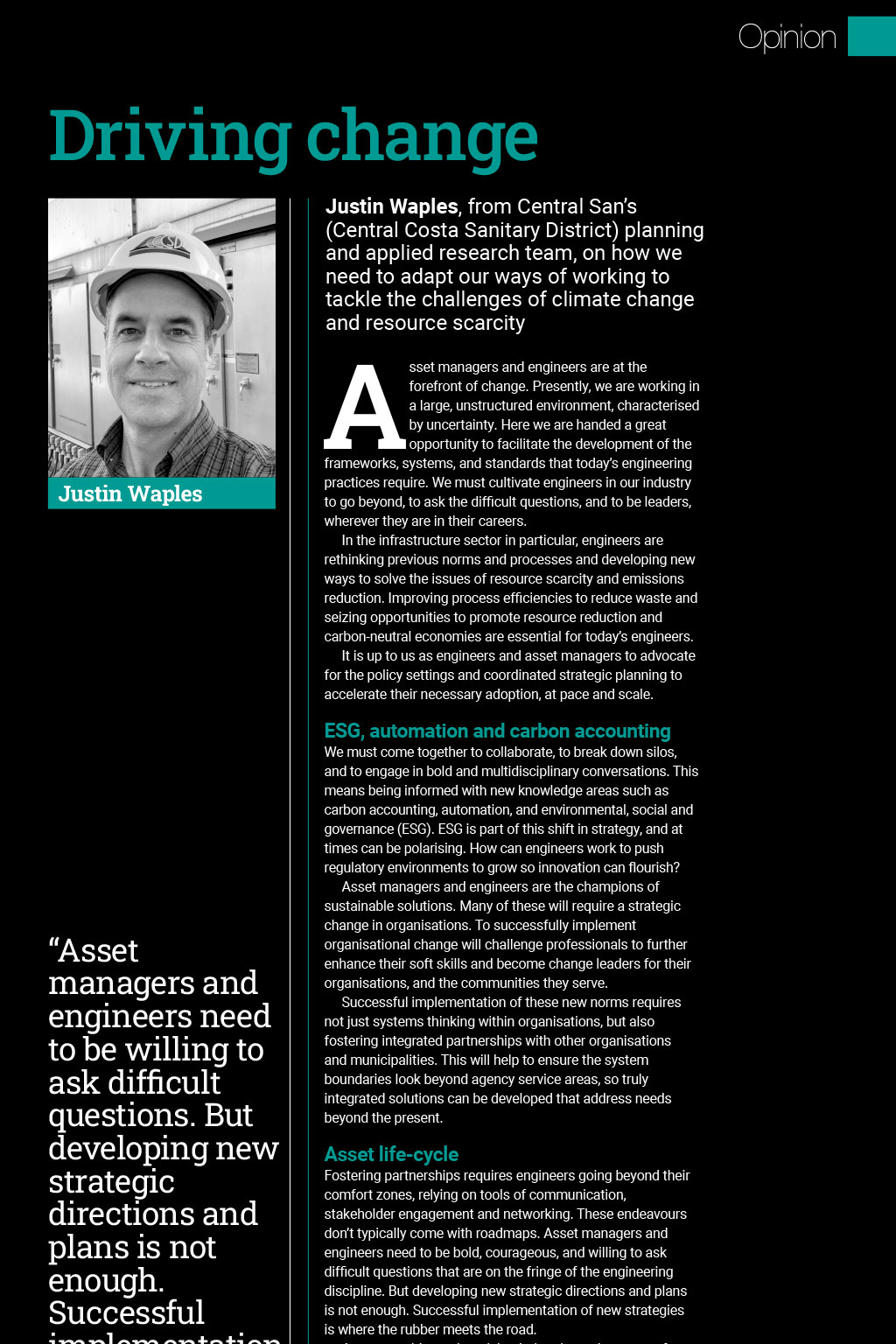




Opinion Driving change Justin Waples, from Central Sans (Central Costa Sanitary District) planning and applied research team, on how we need to adapt our ways of working to tackle the challenges of climate change and resource scarcity Justin Waples Asset managers and engineers are at the forefront of change. Presently, we are working in a large, unstructured environment, characterised by uncertainty. Here we are handed a great opportunity to facilitate the development of the frameworks, systems, and standards that todays engineering practices require. We must cultivate engineers in our industry to go beyond, to ask the difficult questions, and to be leaders, wherever they are in their careers. In the infrastructure sector in particular, engineers are rethinking previous norms and processes and developing new ways to solve the issues of resource scarcity and emissions reduction. Improving process efficiencies to reduce waste and seizing opportunities to promote resource reduction and carbon-neutral economies are essential for todays engineers. It is up to us as engineers and asset managers to advocate for the policy settings and coordinated strategic planning to accelerate their necessary adoption, at pace and scale. ESG, automation and carbon accounting Asset managers and engineers need to be willing to ask difficult questions. But developing new strategic directions and plans is not enough. Successful implementation of new strategies is where the rubber meets the road We must come together to collaborate, to break down silos, and to engage in bold and multidisciplinary conversations. This means being informed with new knowledge areas such as carbon accounting, automation, and environmental, social and governance (ESG). ESG is part of this shift in strategy, and at times can be polarising. How can engineers work to push regulatory environments to grow so innovation can flourish? Asset managers and engineers are the champions of sustainable solutions. Many of these will require a strategic change in organisations. To successfully implement organisational change will challenge professionals to further enhance their soft skills and become change leaders for their organisations, and the communities they serve. Successful implementation of these new norms requires not just systems thinking within organisations, but also fostering integrated partnerships with other organisations and municipalities. This will help to ensure the system boundaries look beyond agency service areas, so truly integrated solutions can be developed that address needs beyond the present. Asset life-cycle Fostering partnerships requires engineers going beyond their comfort zones, relying on tools of communication, stakeholder engagement and networking. These endeavours dont typically come with roadmaps. Asset managers and engineers need to be bold, courageous, and willing to ask difficult questions that are on the fringe of the engineering discipline. But developing new strategic directions and plans is not enough. Successful implementation of new strategies is where the rubber meets the road. As we consider project risks during the early stages of a new initiative, we need to approach that analysis from a systems perspective, identifying how the project may interact with its immediate surroundings, including people and process, and from the perspective of resilience and end-of-life decommissioning. We need to do project scope risk analysis that looks beyond the immediacy of the engineering problem to be solved. We need to ensure we are exploring what issues could be on the horizon. Are we asking the right questions? The Sixth IPCC Assessment Report on Impacts, Adaptation, and Vulnerability reveals that North America will be further exposed to exacerbating risks. If we consider water resources in the US, without accelerated change there are potentially dire consequences for communities, food production and ecosystems, as well as livelihoods and economies. Adaptation to these risks requires integration and coordination across governments, municipalities, and industry. Adaptation will also require new policies and new financial mechanisms. For those conversations to evolve at the pace required, we all need to contribute by fostering conversations within our organisations, with our ratepayers, our regulators, and our elected officials. Leading the way Justin Waples is a Strategic Infrastructure Planning Engineer with Central San, a water resources recovery utility in the San Francisco Bay Area. An environmental engineer by training, Waples is spearheading his organisations adoption of the Envision rating system for sustainable, resilient, and equitable infrastructure. As the Chair of the American Society of Civil Engineers San Francisco Section Sustainability Committee, his vision is to support regional inter-agency collaboration in sustainability, including the development of circular economies. He is both a Chartered Engineer (Australia) and Professional Engineer (California, Texas), and serves as a volunteer on the Envision Review Board for the Institute for Sustainable Infrastructure. Strategic implementation success requires that the process itself needs to be managed like any other project. Competency in strategy implementation is rare, and people who are successful in this field are in strong demand. To ensure we rise to the challenges that confront our industry, this skill deficit must be challenged. We need to ensure the success rate of strategy implementation is high because the consequence of implementation failure is more significant than ever. We need to ensure that asset managers and engineers are fully equipped to deliver on the needs of humanity. Every one of us is in a leadership position, either formally or informally. We must push ourselves further, to lead by example, to ask difficult questions that may be uncomfortable to discuss, to be inclusive and collaborative. We need to support our younger generation and encourage out-of-the-box thinking and engagement. Encouraging diversity can promote the creativity to develop and implement solutions we need. We need to be the change we want to see in the world. It is up to all of us to engage in these challenges and reframe our thinking. There is no room for passengers on this bullet train to a significant paradigm shift in the industry. Everyone needs to be in the drivers seat. Join the conversation Our October issue will be looking in more detail at ESG in asset management. If you would like to submit an article or opinion, please get in contact with us at assets@theiam.org